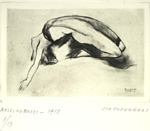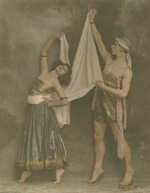Cia Fornaroli

Bucci drypoint
Born in Milan
in 1888 and trained at La Scala, Cia Fornaroli made her debut as première
danseuse at the Metropolitan Opera during the 1910-1911 season. She danced
at the Met until 1913, went to Spain, and made her first visit to Argentina, where she performed at the Teatro Colón
in Buenos Aires. Returning to Italy,
she made several films, then in 1920, with a contract from the Italian impresario
Walter Mocchi and accompanied by her mother, an orchestra, and a chorus of
sixty from Rome's Teatro Costanzi, she embarked on a five-month tour of South
America in 1920 that took her to Rio de Janeiro, Sao Paolo, Montevideo, and
the Teatro Coliseo in Buenos Aires. The end of the year found her back on
Rome at the Teatro Costanzi, where she appeared in
Mârouf, savetier du
Caire (Marouf,
[CHECK] of Cairo), an opera by Henry Rabaud, and other works. In
1922 she was engaged by Arturo Toscanini, then general manager of La Scala,
as prima ballerina of the celebrated house. She appeared in a number of
historic productions, including
Il Convento Veneziano (The Venetian
Convent) to a score by Alfredo Casella,
Petrouchka (with Enrico Cecchetti
as the Old Showman and Anatole Oboukhoff in the title role), and
Legend
of Joseph, to Richard Strauss score originally commissioned by the Ballets
Russes. After Enrico Cecchetti's death in 1928, she became director of the
La Scala school, a post she held until 1932. In 1933, with financial and
creative support from Walter Toscanini, she formed a short-lived chamber
company based in San Remo, for which she choreographed a number of works, to scores
by classical as well as contemporary Italian composers such as Francesco
Malipiero and Ildebrando Pizzetti. In 1938 she joined her husband Walter
Toscanini in New York, where she
established herself as a popular teacher. She founded the Cecchetti Method
School of Classical Dancing in 1948 and four years later assumed the post
of ballet mistress at the Metropolitan Opera. She died in 1954.
Cia Fornaroli in Marouf at the Teatro
Costanzi, Rome, [1920]
Photo by Bragaglia. Cia Fornaroli Collection, Jerome Robbins Dance Division.
Cia Fornaroli
Drypoint by Anselmo Bucci, signed and dated
1918. Anselmo Bucci was a Milan-based painter who belonged to the "Novecento" (1900s)
group founded by Margherita Safatti, one of the most authoritative Italian
art critics of the 1920s. Walter Toscanini commissioned Bucci to portray
Cia Fornaroli in several poses. Cia Fornaroli Collection, Jerome Robbins
Dance Division.
Cia Fornaroli and Ricardo Nemanoff at the
Teatro Coliseo, Buenos Aires, 1920
 Samson
e Dalila
Samson
e Dalila
Tinted photographs by Kitzler, Buenos
Aires, 1920. Clockwise from upper left: "Ballet de la tentation" (Temptation
Ballet) from the opera
Thaïs, an unidentified pas de deux (possibly
from the opera
Carmen or
La Gioconda), a dance from the opera
Samson
e Dalila (possibly the Bacchanale), and
La Midinette (probably
a concert number). Ricardo (or Richard) Nemanoff (also known as Neumanoff)
was a dancer, teacher, and choreographer active in Buenos
Aires in the early twentieth century. Jerome Robbins Dance Division.
Teatro alla Scala, 1925-1926 Season
Poster. This poster records not only the growing
interest in musical modernism at La Scala during the 1920s but also the musical
impact of Diaghilev's Ballets Russes. Among the season's announced offerings
were the Italian premieres of Igor Stravinsky's Le Rossignol, Modest
Mussorgsky's Khovanschchina, Maurice Ravel's L'Enfant et les sortilèges (which
was not actually performed until 1948), as well as a new production of Stravinsky's Petrouchka--all
previously staged by the Diaghilev company. The season also included the
Italian premiere of Gabriele d'Annunzio's multimedia play Le Martyre de
Saint-Sébastien (The Martyrdom of St. Sebastian) starring Diaghilev alumna
Ida Rubinstein. Despite La Scala's seemingly renewed interest in dance,
its ballet personnel--Enrico Cecchetti (Director of the School of Ballet),
Giovanni Pratesi (Choreographer), Angelina Gini (Mistress of the School of
Ballet), and Cia Fornaroli (Prima Ballerina)--were definitely second-class
citizens. The Toscanini Legacy Papers, Music Division.
Cia Fornaroli in Casanova a Venezia (Casanova
in Venice)
Etching and aquatint by Fusetti, [Milan,
1929]. Cia Fornaroli as Lauretta in Heinrich Kröller's ballet Casanova
a Venezia, which premiered at La Scala in 1929. Cia Fornaroli Collection,
Jerome Robbins Dance Division.
Cia Fornaroli in various roles
Photographs. Clockwise from upper left: Cia
Fornaroli in the divertissement from the opera Khovanshchina, La Scala,
1926; Legend of Joseph, La Scala, 1928; as Fanny Elssler in the ballet Cupido
in Schönbrunn, Sironi-Ballet, Vienna, 1923 (Residenz Atelier, Vienna); Histoire
d'un Perrot (History of a Perrot), Compagnia di Balletto Italiano da
Camera (Italian Chamber Ballet Company), San Remo, 1933. The image of Fornaroli
as Fanny Elssler was one of Walter Toscanini's favorite photographs of his
wife. Jerome Robbins Dance Division.
Diploma for Cia Fornaroli's private ballet
academy, with the celebrated image of Jules Perrot's Pas de Quatre
In early 1930s Cia Fornaroli established her
Academy of Classical Ballet in Milan. Although inspired by the the traditions
of La Scala, as embodied in the teachings of Enrico Cecchetti, her school
remained unaffiliated with the theater. The celebrated image of the Pas
de Quatre, which Walter Toscanini adopted as the emblem for her school,
is displayed on the south wall of this exhibition. Cia Fornaroli Collection,
Jerome Robbins Dance Division.
Walter Toscanini
With his father, the conductor Arturo
Toscanini. The Toscanini Legacy Papers, Music Division.
At work in the recording studio. Photograph
by Ken Heyman, 1955. The Toscanini Legacy Papers, Music Division.
L'Arte della danza e l'Arte di Cia Fornaroli (The art of the dance
and the art of Cia Fornaroli)
Milan, 1923. Although uncredited, this published tribute to Cia Fornaroli's
art was written by her future husband, Walter Toscanini. Walter Toscanini
Collection, Jerome Robbins Dance Division.
Cia Fornaroli in street dress, 1915
Postcard. Jerome Robbins Dance Division.
Cia Fornaroli in the early 1910s
Photograph. Jerome Robbins Dance Division.
Arena di Verona (Verona Arena)
Handbill announcing the Arena's summer 1922 program, which included the operas Lohengrin and Pagliacci and
the ballet Carillon Magico, with Cia Fornaroli. Walter Toscanini Collection,
Jerome Robbins Dance Division.
Letter from Enrico Cecchetti to Cia Fornaroli after his appointment as
director of dance at La Scala, 1925
The letter reads in part: "I am very grateful for your kind and lovely
letter of congratulations at my honorary [sic] appointment as Director of the
Academy of Dance of La Scala...[and] assure you...that I shall do everything
possible to render me worth of it and to return our glorious temple of Terpsichore
to its former splendor." It was Walter Toscanini who had urged his father,
Arturo Toscanini, as La Scala's artistic director and principal conductor,
to engage Cecchetti. This letter, although written to Cia Fonaroli, was actually
intended for the Maestro. Walter Toscanini Collection of Research Materials
in Dance, Jerome Robbins Dance Division.
Portrait of Enrico Cecchetti
Photograph, inscribed by "Maestro Prof. Enrico Cecchetti" to his "dear,
adorable, most intelligent pupil Cia Fornaroli," with "affectionate" regards,
Easter 1927. Walter Toscanini Collection of Research Materials in Dance, Jerome
Robbins Dance Division.
Accademia di Danza Classica Italiana (Academy of Italian Classical
Dance)
Brochure of the private academy financed by Walter Toscanini and directed
by Cia Fornaroli in Milan in the early 1930s. The curriculum followed the "Enrico
Cecchetti Method." Walter Toscanini Collection of Research Materials
in Dance, Jerome Robbins Dance Division.
Letter from Victor Dandré to Cia Fornaroli, 30 November 1928
Written on behalf of Anna Pavlova after the death of Enrico Cecchetti, Dandré implores
the Italian ballerina to relay "all the details of the last moments of
our poor Master." Cecchetti died suddenly. One day he felt ill in class,
and the next day he was dead. Fornaroli, Walter Toscanini, and many of Cecchetti's
pupils were with him during his dying hours. Walter Toscanini Collection of
Research Materials in Dance, Jerome Robbins Dance Division.
Cia Fornaroli in New York
The ballerina's personal photo album, with snapshots taken in Central Park
in 1912. Walter Toscanini Collection, Jerome Robbins Dance Division.